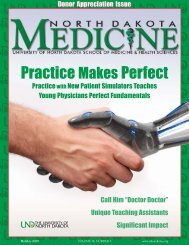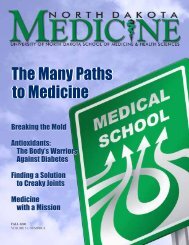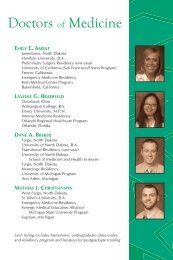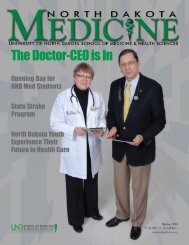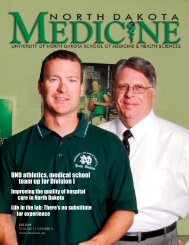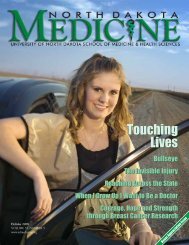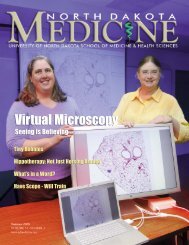View PDF - North Dakota Medicine
View PDF - North Dakota Medicine
View PDF - North Dakota Medicine
- No tags were found...
Create successful ePaper yourself
Turn your PDF publications into a flip-book with our unique Google optimized e-Paper software.
“We want to<br />
speed up and encourage<br />
... translational research ...<br />
that takes discoveries at<br />
the bench in the lab<br />
and actually applies<br />
”<br />
them<br />
to the bedside.<br />
“So that we can more quickly develop<br />
the evidence base for optimal medical<br />
practice,” Wynne said. “Given the fact that<br />
roughly two out of three physicians in this<br />
state are on our clinical faculty, that’s a<br />
wonderful network to use to develop<br />
clinical trials and translational research<br />
protocols so, again, we can take discoveries<br />
in the lab and bring them to the bedside.”<br />
The third is to enhance the focus on<br />
population health.<br />
“It’s been estimated that upward of 40<br />
percent of deaths in this country could be<br />
delayed, with an accompanying increase in<br />
quality of life, if people took better care of<br />
themselves,” Wynne said. “For example, if<br />
we could get people to stop smoking,<br />
reduce their drinking, exercise more, and<br />
lose weight, we could have a substantial<br />
improvement in our community health,<br />
and an improvement in life expectancy and<br />
quality of life for individual members of<br />
that community.”<br />
That’s why the SMHS developed a<br />
Master of Public Health (MPH) degree<br />
program in conjunction with <strong>North</strong><br />
<strong>Dakota</strong> State University—it’s an effort to<br />
shift the focus from individual health to<br />
group, or community, health.<br />
“We want to focus on research<br />
questions that revolve not only around<br />
‘why does my grandmother have<br />
Alzheimer’s and what should we do to treat<br />
her’ to questions like ‘what can we do to<br />
improve the health of Grand Forks in a<br />
global way with my grandmother being a<br />
member of that community, but not the<br />
only one there.’”<br />
Meanwhile, Wynne noted, the SMHS<br />
continues to build on its successful<br />
research tradition.<br />
A look at a sample from this year’s<br />
grant awards shows how and why.<br />
Doing well<br />
“We’re doing fairly well,” said Barry<br />
Milavetz, PhD, professor of biochemistry<br />
and molecular biology at the SMHS and<br />
UND associate vice president for research<br />
development and compliance. “The<br />
medical school brings in about 20 percent<br />
of the research dollars coming into UND.”<br />
About 95 percent of the external<br />
support received by the SMHS comes from<br />
the National Institutes of Health (NIH), an<br />
agency of the federal Department of Health<br />
and Human Services. This year’s NIH<br />
funding to the medical school included<br />
two new R01 grants, five years each at<br />
$250,000 per year, one to Joyce Ohm and<br />
another to Colin Combs (see list below).<br />
“UND itself has been very fortunate in<br />
previous years to get semicompetitive<br />
federal earmarks, but the medical school<br />
by and large doesn’t benefit from that,” said<br />
Milavetz, himself a recipient of federal<br />
research grants; he’s also a reviewer on an<br />
NIH committee that looks over grant<br />
applications. “Almost all of the medical<br />
school’s grant dollars emanate from<br />
competitive grants, and its overall rate of<br />
success is more than 12 percent.”<br />
Research, according to Milavetz, is the<br />
key to maintaining credibility and expertise.<br />
“At a basic philosophical level, a lot of<br />
people believe that in order to be a good<br />
teacher you need to be an expert in your<br />
field,” Milavetz said. “The way you<br />
demonstrate—and continue to<br />
demonstrate—that expertise is by doing<br />
research. We, the SMHS, are a research<br />
institution. It’s critical that our faculty be<br />
active researchers.”<br />
$15.9 million—<br />
largest grant in SMHS history<br />
For Don Sens, PhD, federal dollars are the<br />
key to helping the younger generation<br />
develop an interest in science and the health<br />
professions. Sens, professor of pathology and<br />
a longtime cancer researcher, coordinates<br />
the <strong>North</strong> <strong>Dakota</strong> INBRE (Institutional<br />
Development Award [IDeA] Network of<br />
Biomedical Research Excellence) program.<br />
“INBRE gets awarded to 25 states that<br />
together get less than 5 percent of the NIH<br />
budget of about $30 billion,” Sens said.<br />
“The INBRE grants are used to develop<br />
infrastructure, for example, labs, not just<br />
here at UND but around the state. A big<br />
part of that is getting undergraduates in all<br />
of <strong>North</strong> <strong>Dakota</strong>’s colleges and universities<br />
interested in research and health professions.<br />
Our INBRE grant, administered here at the<br />
SMHS, helps to support undergraduate<br />
research programs at, in addition to UND,<br />
Minot, Valley City, Mayville, Dickinson,<br />
Little Hoop, and Turtle Mountain.”<br />
INBRE now is in the fourth year of a<br />
$15.9 million, five-year NIH grant, which<br />
14 NORTH DAKOTA MEDICINE Holiday 2012



